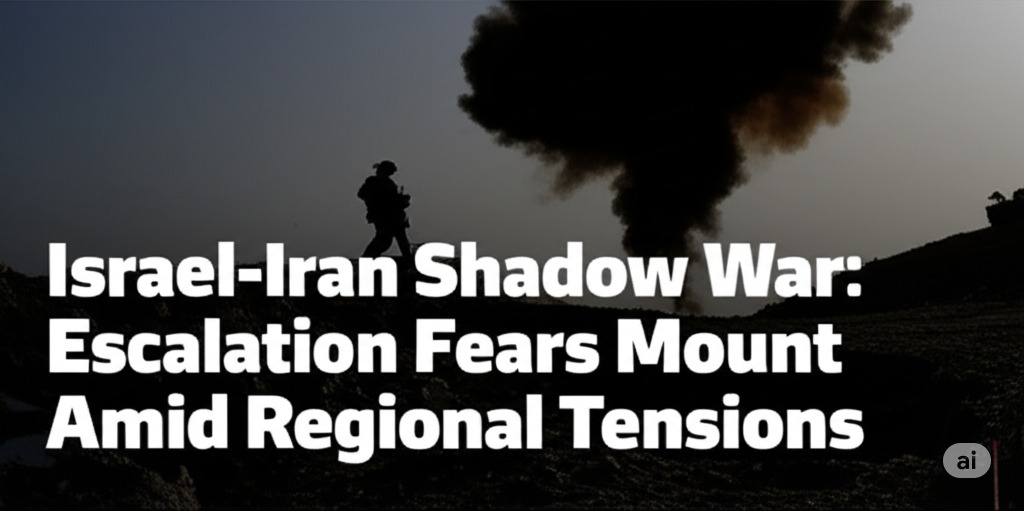Israel-Iran Shadow War: Escalation Fears Mount Amid Regional Tensions
Published on May 18, 2024 | Generated by AI
 🤖 AI-generated Image
🤖 AI-generated Image
Why It Matters
Tensions between Israel and Iran, long simmering below the surface in a 'shadow war,' have recently intensified, bringing the long-standing rivalry into the open and raising fears of broader regional conflict. This escalation is critical now due to direct exchanges of fire following years of proxy conflicts and cyber warfare. Key actors involved include the states of Israel and Iran, along with various regional proxies like Hezbollah in Lebanon and Houthi rebels in Yemen, often supported by Iran. What's at stake is regional stability, the potential for a direct military confrontation between two heavily armed states, and the security of international shipping lanes and energy supplies. The current climate of heightened alert means any miscalculation could rapidly spiral into a wider war with devastating consequences for the Middle East and beyond.
Background & Timeline
The animosity between Israel and Iran dates back to Iran's 1979 Islamic Revolution, which replaced a pro-Western monarchy with an anti-Israel theocracy. Initially, relations were complex, but antagonism solidified in the 1980s. Iran began supporting militant groups like Hezbollah and Hamas, challenging Israel's security along its borders. The conflict evolved into a 'shadow war' characterized by proxy conflicts, covert operations, cyber attacks, and targeted killings, particularly concerning Iran's nuclear program which Israel views as an existential threat. Major milestones include Israel's alleged strikes on Iranian assets in Syria, Iran's support for regional militias targeting Israel, and cyber exchanges. The Iran Nuclear Deal (IAEA) signed in 2015 temporarily eased some tensions but also highlighted deep disagreements, especially after the US withdrew in 2018, leading to renewed pressure and increased hostile activities from both sides.
What’s Happening Now
- May 17, 2024: Reports emerge of continued Israeli airstrikes targeting alleged Iranian-linked sites in Syria.
- May 16, 2024: Senior Israeli officials reiterate readiness to counter Iranian aggression directly if necessary.
- May 15, 2024: Iranian state media covers military exercises showcasing missile capabilities, perceived as a message to regional adversaries.
- May 14, 2024: International bodies express concern over the potential for escalation and call for de-escalation from both Israel and Iran.
What Could Happen Next
-
1. De-escalation through Mediation – Reason: Intense international pressure and the high cost of conflict could push both sides towards indirect talks facilitated by third parties. Expected consequences: Reduced proxy attacks, temporary halt in overt hostile actions, but underlying strategic rivalry remains. This scenario faces challenges due to deep mistrust and hardline factions on both sides.
2. Continued Shadow War – Drivers: Both sides prefer to avoid a costly, all-out war while continuing to weaken the other through proxies, cyber attacks, and covert operations. Risks: High potential for miscalculation leading to unintentional direct conflict, prolonged instability in neighboring states, and continued low-level violence. This is a highly probable scenario given the historical pattern.
3. Direct Military Confrontation – Justification: A significant misstep, a major attack on critical infrastructure, or a perceived existential threat could trigger a direct exchange of fire between Israeli and Iranian forces. Probability: Low in the short term due to mutual deterrence and awareness of catastrophic outcomes, but high in the medium-to-long term if the shadow war intensifies unchecked. Consequences would be severe, involving widespread regional conflict, potential disruption of global energy markets, and significant casualties.
This article is generated using AI-assisted summaries and verified timelines.
